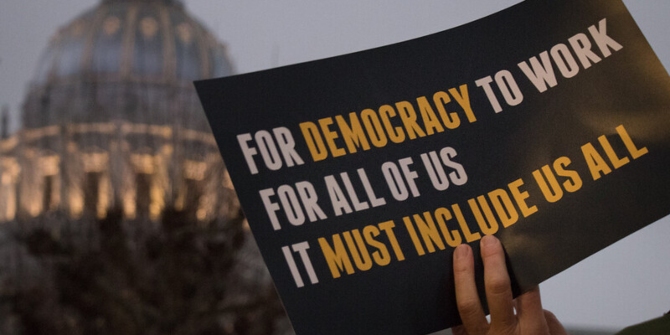
 While more women than ever are running for – and winning – US state governorships, they still run at lower rates than men. In new research, William R. Wilkerson and Alana S. Jeydel look at what encourages and discourages women from running for governor. Looking at more than 40 years of data, they find that elements of states’ electoral and governing arrangements from public financing to term limits can have an important impact on both Democratic and Republican women’s decision to run for governor. They also find that women – especially Democratic women – are less likely to challenge an incumbent from their own party, something that ultimately may hinder the election of more women to governors’ offices.
While more women than ever are running for – and winning – US state governorships, they still run at lower rates than men. In new research, William R. Wilkerson and Alana S. Jeydel look at what encourages and discourages women from running for governor. Looking at more than 40 years of data, they find that elements of states’ electoral and governing arrangements from public financing to term limits can have an important impact on both Democratic and Republican women’s decision to run for governor. They also find that women – especially Democratic women – are less likely to challenge an incumbent from their own party, something that ultimately may hinder the election of more women to governors’ offices.
Women are running for governor in the US in record numbers. In the 36 states that held elections in 2022, 64 women candidates appeared on a major party primary ballot. In the four-year cycle from 2019-2022, there were 93 women candidates in gubernatorial elections (see Figures 1 and 2).
Figure 1 – Women gubernatorial candidates on the ballot by party

Figure 2 – Women gubernatorial nominees by party

After the 2022 elections, 12 women served as governor, the highest number ever (Figure 3).
Figure 3 – Women governors serving each year

Why do women run for governor – and why don’t they?
Even with this growth, women run for governor at lower rates than men. This dearth of women candidates is not due to a lack of ambition. When and why have there been increases in women running for governor? What discourages women from running? We gathered data on every primary election or convention used to select major party gubernatorial nominees from 1978 to 2022 to understand why and to explore if there were any differences between the parties.
Republican women and Democratic women approach running for governor differently. We expected that the presence and number of women gubernatorial candidates would be significantly related to the number of women holding elective office. This was not true for Democratic women but was for Republican women. As Figure 4 shows, Democrats made a concerted effort over decades to recruit more women to run for state and national elected office, creating a fuller pipeline of potential future candidates for higher office much earlier. Even in the 1980s and 1990s, Democrats had experienced women elected officials who could run for governor. The result has been that the growing ranks of women governors, and women elected officeholders more generally, have largely been Democrats.
Figure 4 – Total women elected officials in the pipeline by Party, 1978–2022

The Republicans have, by and large, not paid the same attention to recruiting women candidates, with Republican women being more individualistic in deciding to run for office, especially high office like governor. The Republican pipeline of potential women candidates for governor is filling up, and those women are serving as role models for other Republican women considering a run. We find a significant pipeline effect for Republicans. In states with more Republican women US Representatives, Republican women state legislators, and Republican women holding “masculine-defined” statewide offices (ex: attorney general, treasurer, tax commissioner, agriculture commissioner) Republican women are more likely, at a statistically significant level, to run for governor.

“SelectUSA Investment Summit 2023” (Public Domain) by InternationalTradeAdministration
The importance of state structural elements around governing
A state’s institutional arrangements for the office of the governor have an important impact on both Democratic and Republican women’s decision to run in a gubernatorial primary. States with more important structural elements— public financing, not allowing for pre-primary party endorsement of candidates, two-year terms of office, term limits, lower salaries (higher salaries attract more, and more qualified, male candidates), and those that decouple the governor and lieutenant governor from tickets—have more women gubernatorial candidates. This finding is of particular importance as it indicates concrete structural changes that can be made that should lead to more women running for governor. They also indicate that while creating a pipeline of qualified women to run for elected office is an important goal, it will not be enough to increase diversity in the ranks of governors.
Political events impact whether women run for governor. The Year of the Woman in 1992, led to more women from both parties running for governor as well as other offices. The nomination of Alaska’s Republican governor, Sarah Palin for Vice President in 2008 had a positive and significant impact on the presence of Republican women on gubernatorial primary ballots in 2009-2010. And gubernatorial elections held after Donald Trump’s 2016 election as president are positively and significantly associated with the presence of women on the ballot for both parties. The number of both Democratic and Republican women candidates has notably increased since 2016. We see this first with Democrats in 2018 and more recently with Republicans.
Figure 5 – Women gubernatorial candidates on the ballot by Party

Democratic women are less likely to challenge incumbent women from their own party
As is true for many potential offices, an incumbent running for reelection discourages women from running for governor. Running against an incumbent is very challenging with little chance of success. We specifically investigated the role of incumbents running in the same party. Not surprisingly, women are less likely to run against same-party incumbent governors.
The gender of the incumbent matters as well. Women are even less likely to challenge same-party women incumbents than male same-party incumbents. While the relationship is significant for both Democrats and Republicans for male incumbents, the impact of a woman incumbent is significant for Democrats, but not Republicans. Republican women are challenging Republican women incumbents. The political parties have different cultures that impact whether and when women in their party are running for governor.
In contrast, open seats do not lead to more women running for governor. It is often assumed that an open seat, one with no incumbent, will attract more women to run. Interestingly, open gubernatorial seats do not, on their own, lead to more women running for governor.
Removing the barriers that discourage women from running for governor
So, what barriers remain that discourage women from running for governor? Women candidates are strategic and continue to be sensitive to the environment around them. First, states and parties can alter structural elements that deter women from running. Gubernatorial tickets can be decoupled, pre-primary endorsements can be eliminated, and public campaign financing can be bolstered, for example. Further, parties can adopt rules and facilitate norms that are favorable to women, working to end the old-boy network that still characterizes much of party culture in the US to this day.
More women governors is far from a certainty.
Our research has found that states that have elected women governors don’t necessarily elect another soon after. Attitudes about women as leaders discourage women from running for governor. Historically, this has been particularly true for Republicans. But Republican women today are taking matters into their own hands and running when and where they want.
And while the Democratic Party has historically had an environment that fostered more women to run, today this may no longer be helping women. Men continue to self-select to run, no matter what the party may or may not have planned, but Democratic women appear to be toeing the party line and not running unless part of a larger plan. The fact that Democratic women are statistically unlikely to challenge an incumbent Democratic woman governor will not lead to more women running and winning. It ultimately may hinder the election of more women to the governor’s office.
Since 2018, the number of women who run for governor, are nominated by their parties, and have won general elections has significantly increased. Given our findings, this trend is not guaranteed to continue. The growth of women candidates will likely depend on future political events and the continuing change in attitudes as structural change is harder to accomplish.
- This article is based on the paper, ‘Why aren’t more women on the gubernatorial ballot?’, in Politics, Groups, and Identities.
- Please read our comments policy before commenting.
- Note: This article gives the views of the author, and not the position of USAPP – American Politics and Policy, nor the London School of Economics.
- Shortened URL for this post: https://wp.me/p3I2YF-dP1






